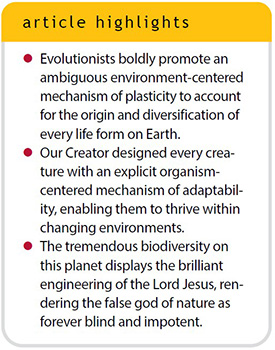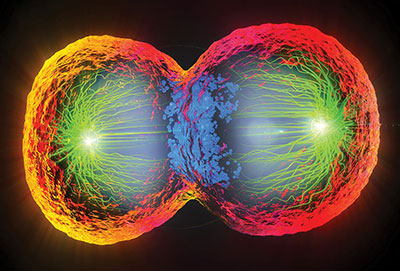Staff Writer
 Among the mechanisms promoted to account for the process of evolution, plasticity is one of the most prominent. This term broadly refers to a capacity for being shaped, altered, or deformed in one or more directions. Within biology, plasticity is primarily used to describe the adaptability of an organism to an external environment. One of the most recognized authorities on this topic proposes that “mechanisms of plasticity include some of the most ingenious and widely conserved creations of nature.”1 Is nature really an ingenious creator with mythical powers?
Among the mechanisms promoted to account for the process of evolution, plasticity is one of the most prominent. This term broadly refers to a capacity for being shaped, altered, or deformed in one or more directions. Within biology, plasticity is primarily used to describe the adaptability of an organism to an external environment. One of the most recognized authorities on this topic proposes that “mechanisms of plasticity include some of the most ingenious and widely conserved creations of nature.”1 Is nature really an ingenious creator with mythical powers?
To understand such mechanisms, we must first define a set of terms in the context of biology.
Genotype: the genetic composition of heritable DNA and RNA in an organism or population of organisms.
Phenotype: the observable physical and behavioral traits of a cell or an organism.
Response: the changes in activity or behavior patterns of an organism as the result of a stimulus.
Environment: the combination of chemical, physical, biological, and climatic conditions that surround an organism at any particular time.
All four terms collectively define the Darwinian mechanism of phenotypic plasticity, “the ability of a single genotype to produce multiple phenotypes in response to variation in the environment.”2 Thus, evolutionists teach that phenotypic plasticity is essentially an environmentally responsive trait that evolves.1,3 Therefore, plasticity is a trait that produces multiple plastic traits by means of natural selection, the core tenet of evolution. And the plasticity of this plastic mechanism apparently operates through active or passive, adaptive or nonadaptive, and reversible or irreversible responses by any multicellular organism on Earth.1 Are you confused yet?
Importantly, plasticity is predicted to act primarily during development, when a tightly regulated progression of order and complexity builds every plant and animal. During early development, molecules, cells, and embryos are exposed to different environments, providing plasticity with a broad flexibility of choices.1,4,5 Environmental inputs during development are also thought to directly shape the responses of organisms and bypass the genome, providing novel morphological traits for natural selection that may,5 or may not,6 be independent of genetics. This is developmental plasticity, a synonym of phenotypic plasticity.1

Clearly, the most “plastic” components of Darwinian plasticity are the Darwinists themselves, not the organisms. They propose a seemingly open-ended mechanism with unlimited flexibility over millions of years to account for the adaptability and diversification of organisms—each assumed to be a highly complex, specialized creation of nature. Evolutionarily speaking, “plasticity must have been an early universal property of living things.”1
ICR’s model of continuous environmental tracking (CET) operates in direct opposition to Darwinian plasticity. Where evolutionists propose that organisms ultimately diversify at the whim of environmental influence, we envision organism-centered adjustments to changing environmental conditions. Thus, we predict that organisms are the agents in control of each adaptive response. They are not molded by inanimate impulses of nature; they determine which elements of the environment are stimuli. Life adapts by integrating molecular, biochemical, cellular, and physiological traits of the whole organism, by the whole organism.
What evolutionists promote as a plastic, unguided, anything-is-possible mechanism to account for the biodiversity of life on this planet we know to be intentional, purposeful, and directed preparations by and through our Creator, Jesus. As for the false promotion of a mythical evolutionary mechanism being “an early universal property of living things,”1 we stand upon Scripture, which tells us not only who but also when He created the heavens, the earth, the sea, and every form of life. “Forever, O LORD, Your word is settled in heaven” (Psalm 119:89).
References
- West-Eberhard, M. J. 2003. Developmental Plasticity and Evolution. New York, NY: Oxford University Press, 34.
- Pfennig, D. W. et al. 2010. Phenotypic plasticity’s impacts on diversification and speciation. Trends in Ecology & Evolution. 25 (8): 459–467.
- Herron, J. C. and S. Freeman. 2014. Evolutionary Analysis, 5th ed. London: Pearson Education, Inc.
- Barresi, M. and S. Gilbert. 2020. Developmental Biology, 12th ed. Sunderland, MA: Sinauer Associates, Inc.
- West-Eberhard, M. J. 2005. Developmental plasticity and the origin of species differences. Proceedings of the National Academy of Sciences. 102 (suppl. 1): 6543–6549.
- Forsman, A. 2015. Rethinking phenotypic plasticity and its consequences for individuals, populations and species. Heredity. 115: 276–284.


















